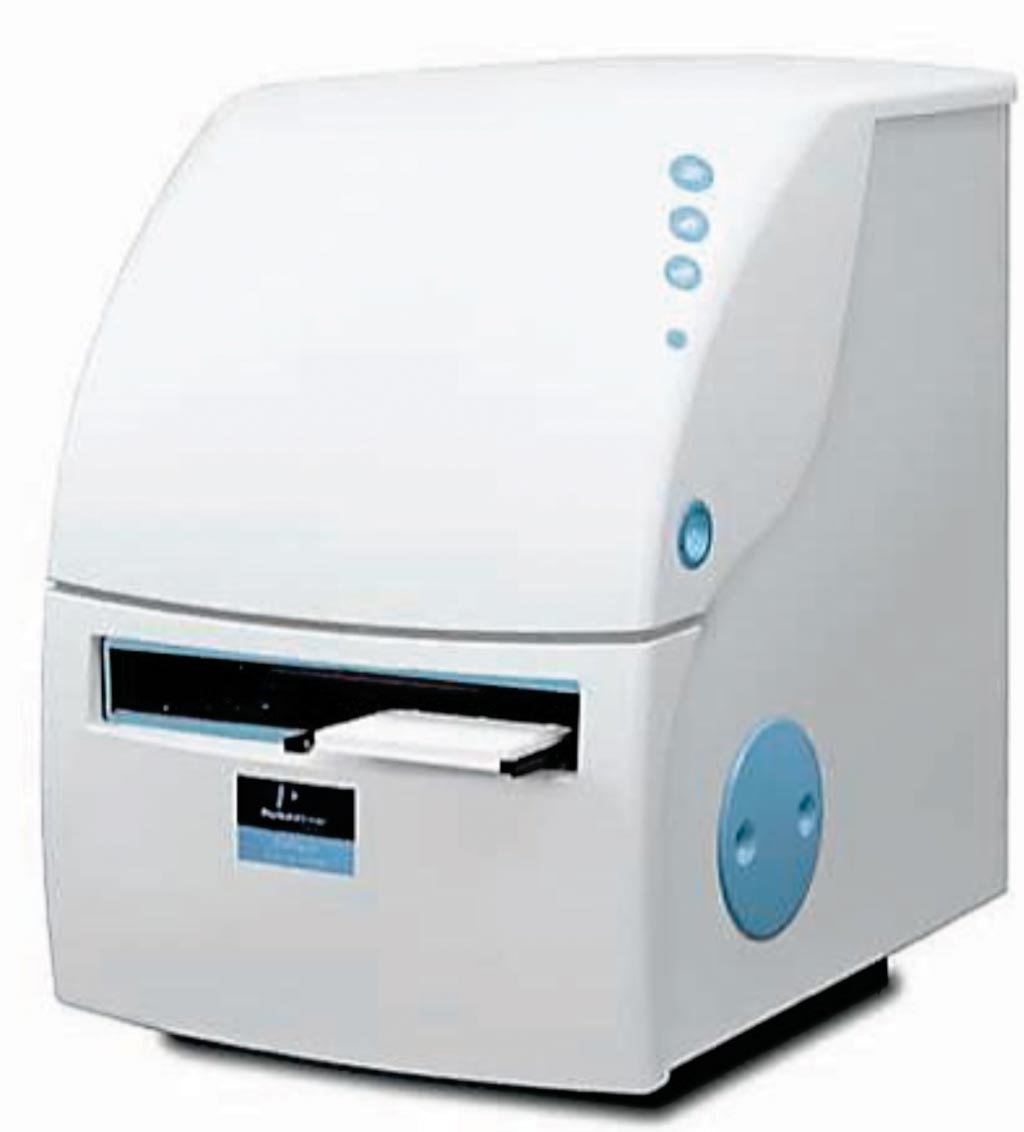Homogeneous BTK Occupancy Assay Developed
|
By LabMedica International staff writers Posted on 02 Aug 2018 |

Image: The EnVision 2105 multimode plate reader provides exceptional speed, ultra-high throughput, and maximum sensitivity across all detection technologies (Photo courtesy of PerkinElmer).
Bruton’s tyrosine kinase (BTK), a member of the tyrosine kinase expressed in the hepatocellular carcinoma (TEC) family of cytoplasmic protein tyrosine kinases, was initially identified as the pathogenic protein in X-linked agammaglobulinemia, a human primary immune deficiency disease.
BTK promotes development and maturation of B cells through activation of cell cycle regulators and differentiation factors, and directs B-cell proliferation and survival through regulation of apoptosis. With its central role in B Cell Receptor (BCR) signaling and survival, BTK is an oncogenic driver in human chronic lymphocytic leukemia (CLL) and activated B-cell-like subtype of diffuse large B-cell lymphoma (ABC-DLBCL).
Scientists from Gilead Sciences, Inc, (Foster City, CA, USA) developed a novel duplex homogeneous BTK occupancy assay based on time-resolved fluorescence resonance energy transfer (TR-FRET) to measure free and total BTK levels in a multiplexed format. The assay can measure target engagement in peripheral blood mononuclear cells (PBMCs) and in lymph node and bone marrow samples. The assay provides accurate, quantitative assessment of BTK occupancy and currently is in use in ongoing tirabrutinib clinical studies.
The assay takes advantage of the dual wavelength emission of terbium conjugated anti-BTK antibody to serve as the energy donor for two fluorescent energy acceptors with distinct excitation and emission spectra: G2-streptavidin-bound biotinylated tirabrutinib and detects free BTK and D2-coupled second anti-BTK antibody that binds to a different BTK epitope and detects total BTK. Additionally, the use of a common fluorescence donor serves to normalize the detection of total and free BTK with respect to each other.
The assay is characterized and quantified using full-length purified recombinant human BTK protein and PBMCs derived from healthy volunteers and patients with CLL. The authors demonstrate the assay's utility using cells derived from samples from patients with CLL and DLBCL. The team used a multiplexed assay for free and total BTK carried out on 384-well assay plates. The processed plates were read on EnVision laser-based reader.
The TR-FRET BTK occupancy assay was validated using purified human recombinant full-length BTK (rBTK) and cell extracts. Based on a set of six studies with quadruplicate samples using rBTK, the assay dynamic range was 9.75 to 312 ng/mL free and total BTK. The lower and upper limits of quantitation were 12 ng/mL (limit of detection 6 ng/mL) and 166 ng/mL, respectively. Variability in free and total BTK levels within the full assay dynamic range was very low, with interassay coefficient of variation (CV) ≤6% for free BTK and ≤3% for total BTK. PBMCs in patients with B-cell malignancies can show very high BTK levels due to enrichment of B cells.
The authors concluded that they had developed, validated, and qualified a TR-FRET-based homogeneous duplex assay to measure BTK occupancy in PBMCs from tirabrutinib clinical studies. Utility of the assay also was demonstrated using cells derived from lymph node and bone marrow samples from patients with CLL and DLBCL. The study was published on July 6, 2018, in the journal SLAS DISCOVERY: Advancing Life Sciences R&D.
Related Links:
Gilead Sciences
BTK promotes development and maturation of B cells through activation of cell cycle regulators and differentiation factors, and directs B-cell proliferation and survival through regulation of apoptosis. With its central role in B Cell Receptor (BCR) signaling and survival, BTK is an oncogenic driver in human chronic lymphocytic leukemia (CLL) and activated B-cell-like subtype of diffuse large B-cell lymphoma (ABC-DLBCL).
Scientists from Gilead Sciences, Inc, (Foster City, CA, USA) developed a novel duplex homogeneous BTK occupancy assay based on time-resolved fluorescence resonance energy transfer (TR-FRET) to measure free and total BTK levels in a multiplexed format. The assay can measure target engagement in peripheral blood mononuclear cells (PBMCs) and in lymph node and bone marrow samples. The assay provides accurate, quantitative assessment of BTK occupancy and currently is in use in ongoing tirabrutinib clinical studies.
The assay takes advantage of the dual wavelength emission of terbium conjugated anti-BTK antibody to serve as the energy donor for two fluorescent energy acceptors with distinct excitation and emission spectra: G2-streptavidin-bound biotinylated tirabrutinib and detects free BTK and D2-coupled second anti-BTK antibody that binds to a different BTK epitope and detects total BTK. Additionally, the use of a common fluorescence donor serves to normalize the detection of total and free BTK with respect to each other.
The assay is characterized and quantified using full-length purified recombinant human BTK protein and PBMCs derived from healthy volunteers and patients with CLL. The authors demonstrate the assay's utility using cells derived from samples from patients with CLL and DLBCL. The team used a multiplexed assay for free and total BTK carried out on 384-well assay plates. The processed plates were read on EnVision laser-based reader.
The TR-FRET BTK occupancy assay was validated using purified human recombinant full-length BTK (rBTK) and cell extracts. Based on a set of six studies with quadruplicate samples using rBTK, the assay dynamic range was 9.75 to 312 ng/mL free and total BTK. The lower and upper limits of quantitation were 12 ng/mL (limit of detection 6 ng/mL) and 166 ng/mL, respectively. Variability in free and total BTK levels within the full assay dynamic range was very low, with interassay coefficient of variation (CV) ≤6% for free BTK and ≤3% for total BTK. PBMCs in patients with B-cell malignancies can show very high BTK levels due to enrichment of B cells.
The authors concluded that they had developed, validated, and qualified a TR-FRET-based homogeneous duplex assay to measure BTK occupancy in PBMCs from tirabrutinib clinical studies. Utility of the assay also was demonstrated using cells derived from lymph node and bone marrow samples from patients with CLL and DLBCL. The study was published on July 6, 2018, in the journal SLAS DISCOVERY: Advancing Life Sciences R&D.
Related Links:
Gilead Sciences
Latest Hematology News
- New Scoring System Predicts Risk of Developing Cancer from Common Blood Disorder
- Non-Invasive Prenatal Test for Fetal RhD Status Demonstrates 100% Accuracy
- WBC Count Could Predict Severity of COVID-19 Symptoms
- New Platelet Counting Technology to Help Labs Prevent Diagnosis Errors
- Streamlined Approach to Testing for Heparin-Induced Thrombocytopenia Improves Diagnostic Accuracy
- POC Hemostasis System Could Help Prevent Maternal Deaths
- New Test Assesses Oxygen Delivering Ability of Red Blood Cells by Measuring Their Shape
- Personalized CBC Testing Could Help Diagnose Early-Stage Diseases in Healthy Individuals
- Non-Invasive Test Solution Determines Fetal RhD Status from Maternal Plasma
- First-Of-Its-Kind Smartphone Technology Noninvasively Measures Blood Hemoglobin Levels at POC

- Next Gen CBC and Sepsis Diagnostic System Targets Faster, Earlier, Easier Results
- Newly Discovered Blood Group System to Help Identify and Treat Rare Patients
- Blood Platelet Score Detects Previously Unmeasured Risk of Heart Attack and Stroke
- Automated Benchtop System to Bring Blood Testing To Anyone, Anywhere
- New Hematology Analyzers Deliver Combined ESR and CBC/DIFF Results in 60 Seconds
- Next Generation Instrument Screens for Hemoglobin Disorders in Newborns
Channels
Clinical Chemistry
view channel
‘Brilliantly Luminous’ Nanoscale Chemical Tool to Improve Disease Detection
Thousands of commercially available glowing molecules known as fluorophores are commonly used in medical imaging, disease detection, biomarker tagging, and chemical analysis. They are also integral in... Read more
Low-Cost Portable Screening Test to Transform Kidney Disease Detection
Millions of individuals suffer from kidney disease, which often remains undiagnosed until it has reached a critical stage. This silent epidemic not only diminishes the quality of life for those affected... Read more
New Method Uses Pulsed Infrared Light to Find Cancer's 'Fingerprints' In Blood Plasma
Cancer diagnoses have traditionally relied on invasive or time-consuming procedures like tissue biopsies. Now, new research published in ACS Central Science introduces a method that utilizes pulsed infrared... Read moreMolecular Diagnostics
view channel
Revolutionary Blood Test Detects 30 Different Types of Cancers with 98% Accuracy
With cancer expected to become the leading cause of global mortality by 2030, early detection remains the most effective strategy to reduce death rates. Current screening methods only cover five types... Read more
Simple Blood Test Better Predicts Heart Disease Risk
Cardiovascular diseases (CVDs) are the primary cause of death worldwide. A large proportion of these cases could be prevented by addressing lifestyle and environmental factors such as smoking, poor diet,... Read moreImmunology
view channel
Stem Cell Test Predicts Treatment Outcome for Patients with Platinum-Resistant Ovarian Cancer
Epithelial ovarian cancer frequently responds to chemotherapy initially, but eventually, the tumor develops resistance to the therapy, leading to regrowth. This resistance is partially due to the activation... Read more
Machine Learning-Enabled Blood Test Predicts Immunotherapy Response in Lymphoma Patients
Chimeric antigen receptor (CAR) T-cell therapy has emerged as one of the most promising recent developments in the treatment of blood cancers. However, over half of non-Hodgkin lymphoma (NHL) patients... Read moreMicrobiology
view channel
Handheld Device Delivers Low-Cost TB Results in Less Than One Hour
Tuberculosis (TB) remains the deadliest infectious disease globally, affecting an estimated 10 million people annually. In 2021, about 4.2 million TB cases went undiagnosed or unreported, mainly due to... Read more
New AI-Based Method Improves Diagnosis of Drug-Resistant Infections
Drug-resistant infections, particularly those caused by deadly bacteria like tuberculosis and staphylococcus, are rapidly emerging as a global health emergency. These infections are more difficult to treat,... Read more
Breakthrough Diagnostic Technology Identifies Bacterial Infections with Almost 100% Accuracy within Three Hours
Rapid and precise identification of pathogenic microbes in patient samples is essential for the effective treatment of acute infectious diseases, such as sepsis. The fluorescence in situ hybridization... Read morePathology
view channel
Sensitive and Specific DUB Enzyme Assay Kits Require Minimal Setup Without Substrate Preparation
Ubiquitination and deubiquitination are two important physiological processes in the ubiquitin-proteasome system, responsible for protein degradation in cells. Deubiquitinating (DUB) enzymes contain around... Read more
World’s First AI Model for Thyroid Cancer Diagnosis Achieves Over 90% Accuracy
Thyroid cancer is one of the most common cancers worldwide, and its precise management typically relies on two primary systems: (1) the 8th edition of the American Joint Committee on Cancer (AJCC) or ... Read more
Breakthrough Diagnostic Approach to Significantly Improve TB Detection
Tuberculosis (TB) remains the deadliest infectious disease globally, with 10.8 million new cases and 1.25 million deaths reported in 2023. Early detection through effective screening is crucial in identifying... Read more
Rapid, Ultra-Sensitive, PCR-Free Detection Method Makes Genetic Analysis More Accessible
Genetic testing has been an important method for detecting infectious diseases, diagnosing early-stage cancer, ensuring food safety, and analyzing environmental DNA. For a long time, polymerase chain reaction... Read moreTechnology
view channel
Disposable Microchip Technology Could Selectively Detect HIV in Whole Blood Samples
As of the end of 2023, approximately 40 million people globally were living with HIV, and around 630,000 individuals died from AIDS-related illnesses that same year. Despite a substantial decline in deaths... Read more
Pain-On-A-Chip Microfluidic Device Determines Types of Chronic Pain from Blood Samples
Chronic pain is a widespread condition that remains difficult to manage, and existing clinical methods for its treatment rely largely on self-reporting, which can be subjective and especially problematic... Read more
Innovative, Label-Free Ratiometric Fluorosensor Enables More Sensitive Viral RNA Detection
Viruses present a major global health risk, as demonstrated by recent pandemics, making early detection and identification essential for preventing new outbreaks. While traditional detection methods are... Read moreIndustry
view channel
Cepheid and Oxford Nanopore Technologies Partner on Advancing Automated Sequencing-Based Solutions
Cepheid (Sunnyvale, CA, USA), a leading molecular diagnostics company, and Oxford Nanopore Technologies (Oxford, UK), the company behind a new generation of sequencing-based molecular analysis technologies,... Read more
Grifols and Tecan’s IBL Collaborate on Advanced Biomarker Panels
Grifols (Barcelona, Spain), one of the world’s leading producers of plasma-derived medicines and innovative diagnostic solutions, is expanding its offer in clinical diagnostics through a strategic partnership... Read more









 Assay.jpg)









